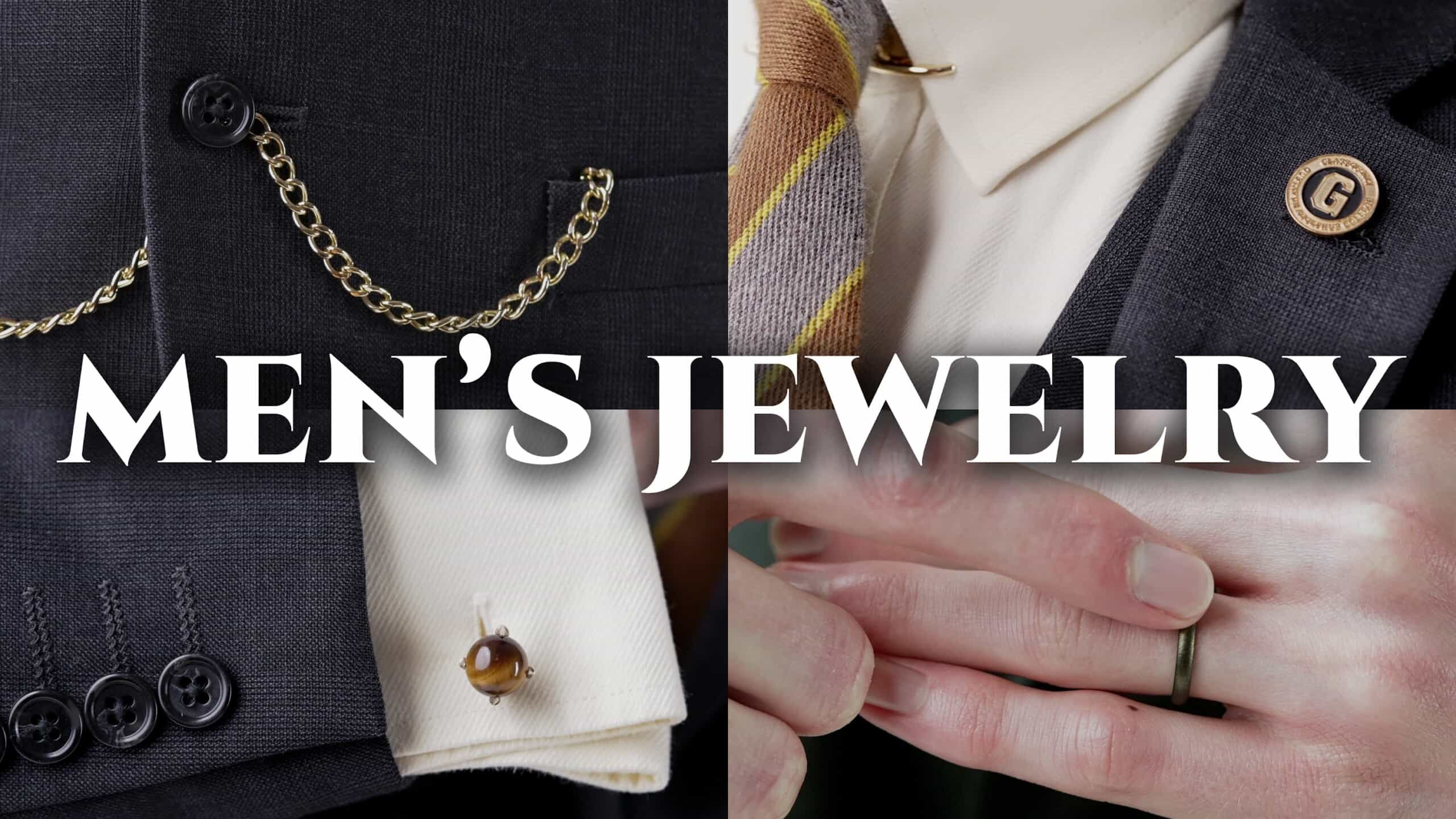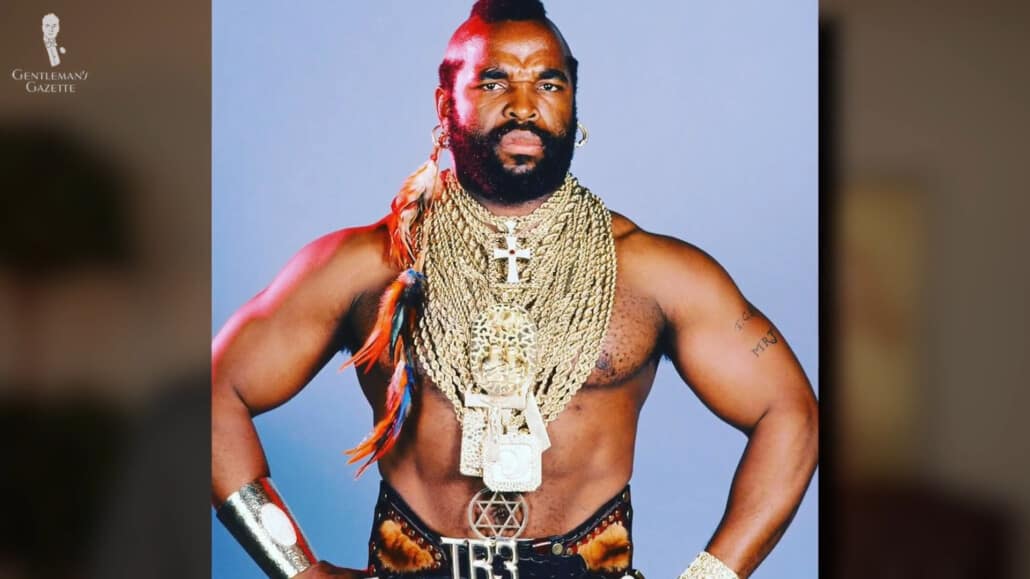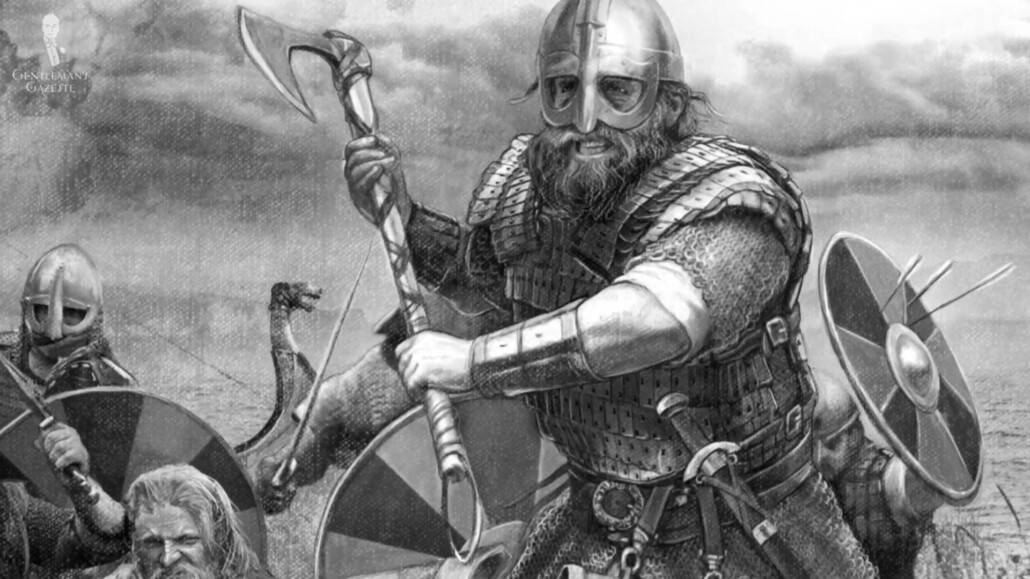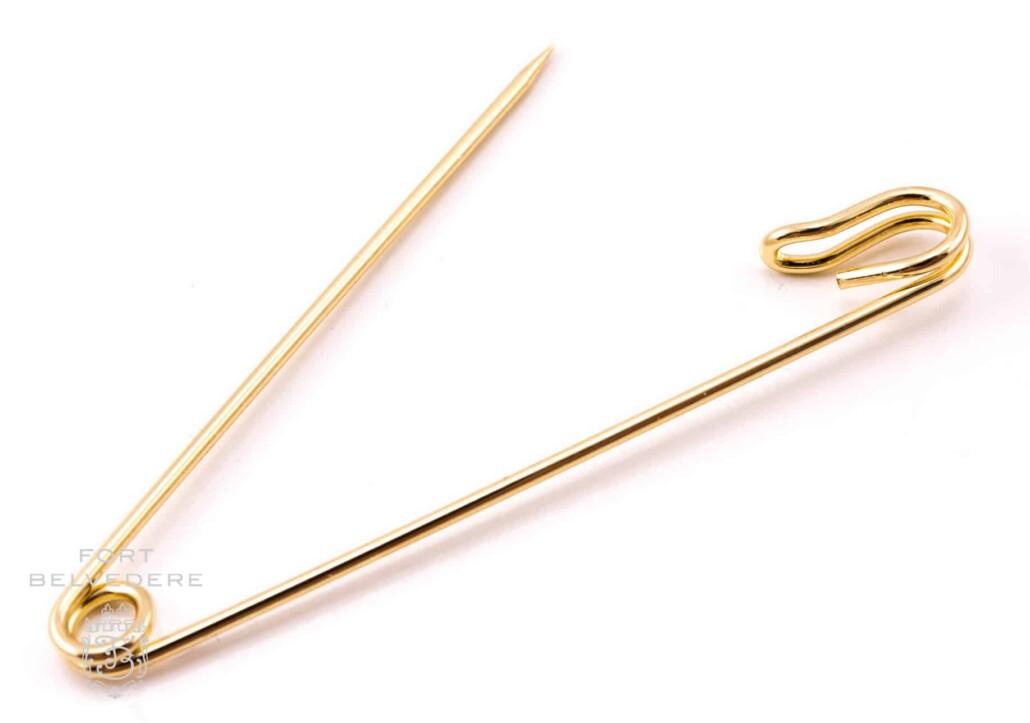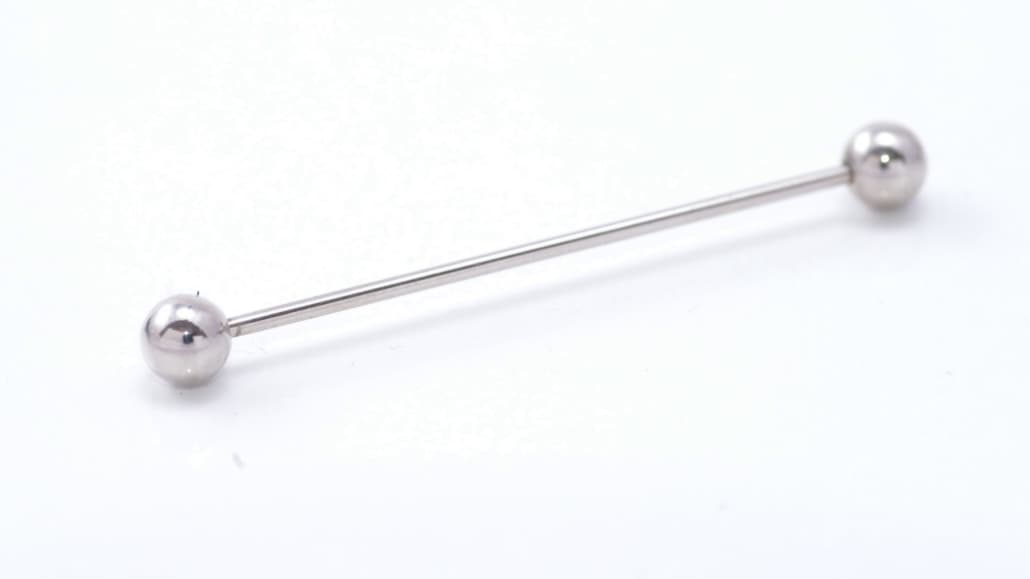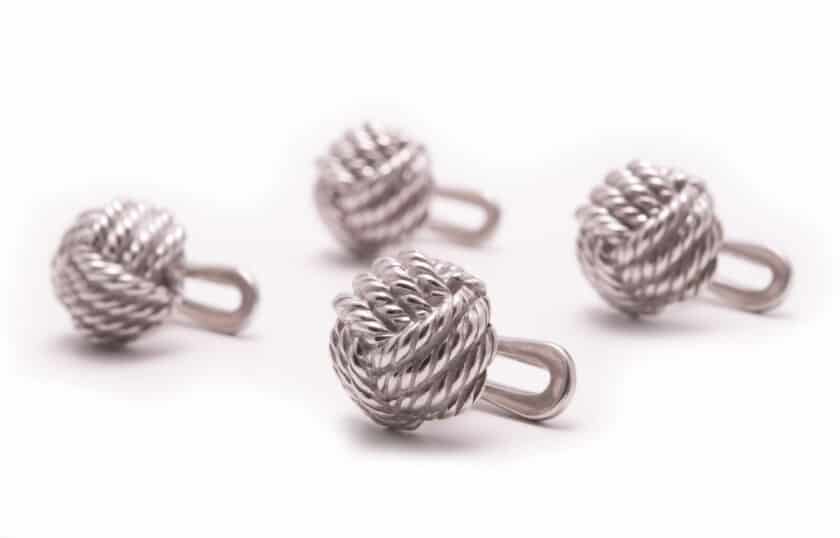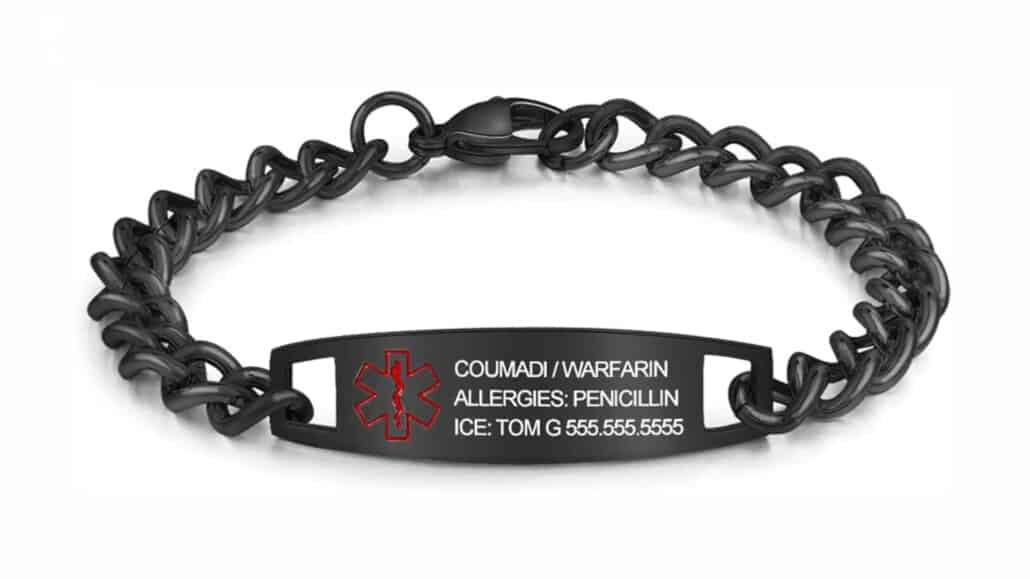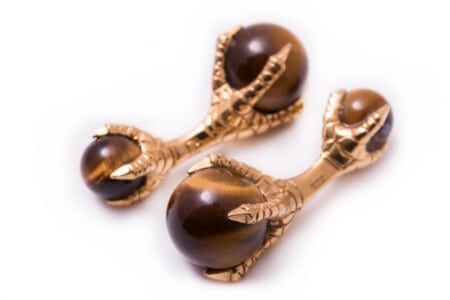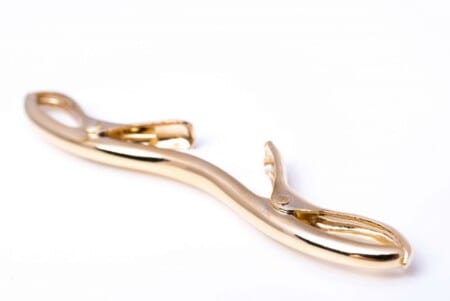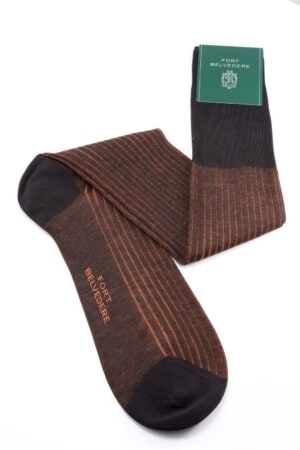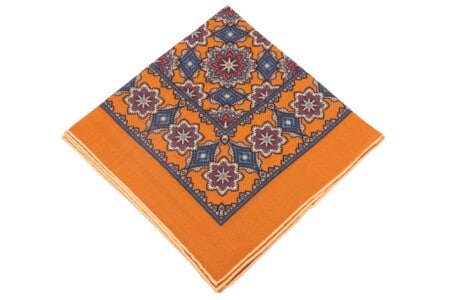While the popularity of jewelry has waxed and waned over the decades and centuries, jewelry definitely does have a place within classic menswear. So, we have an ultimate overview of men’s jewelry, including its history, the different and most common types, and an overall description of their functionality to understand these frequently misunderstood accessories!
Oftentimes, when one hears the phrase “men’s jewelry,” one is tempted to think of the excesses – epic though they may be – of a figure like the actor and wrestler Mr. T, but we pity the fool who dismisses men’s jewelry outright.
While our Definitive Guide series goes into greater depth on one specific piece or accessory, today, we go more for breadth to have a more general view of jewelry.
History of Men’s Jewelry
The oldest extant pieces of men’s jewelry are pieces of seashells that could be over a hundred thousand years old. From what we can tell, it’s likely that the shell fragments were crafted into beads in order to be worn.
Similarly, the oldest known pieces of gold jewelry are also beads found in Bulgaria and date to about 4600 B.C. Meanwhile, the oldest rings known to man were found in the Indus River Valley, and these have been dated more generally to the third millennium B.C.
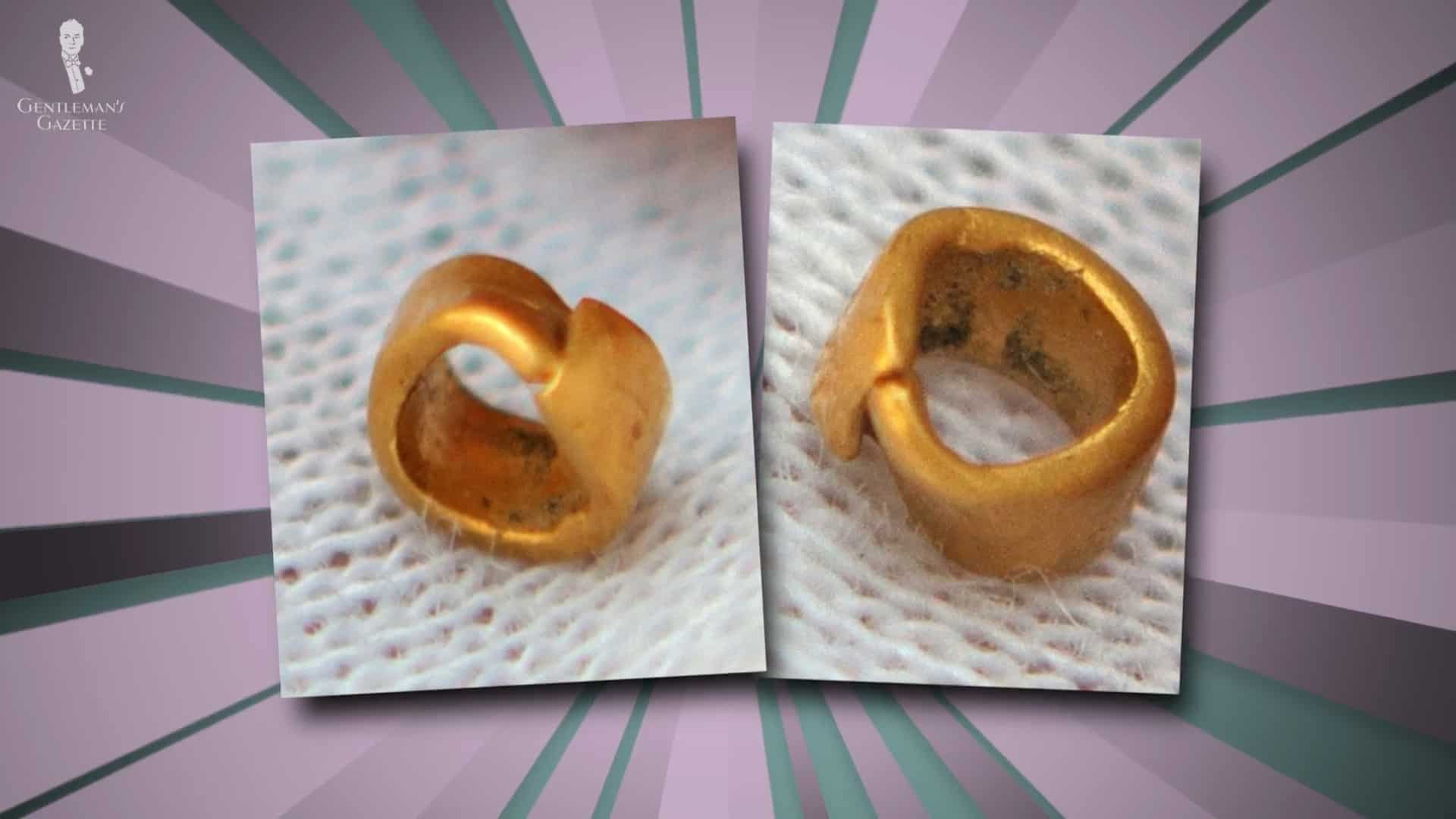
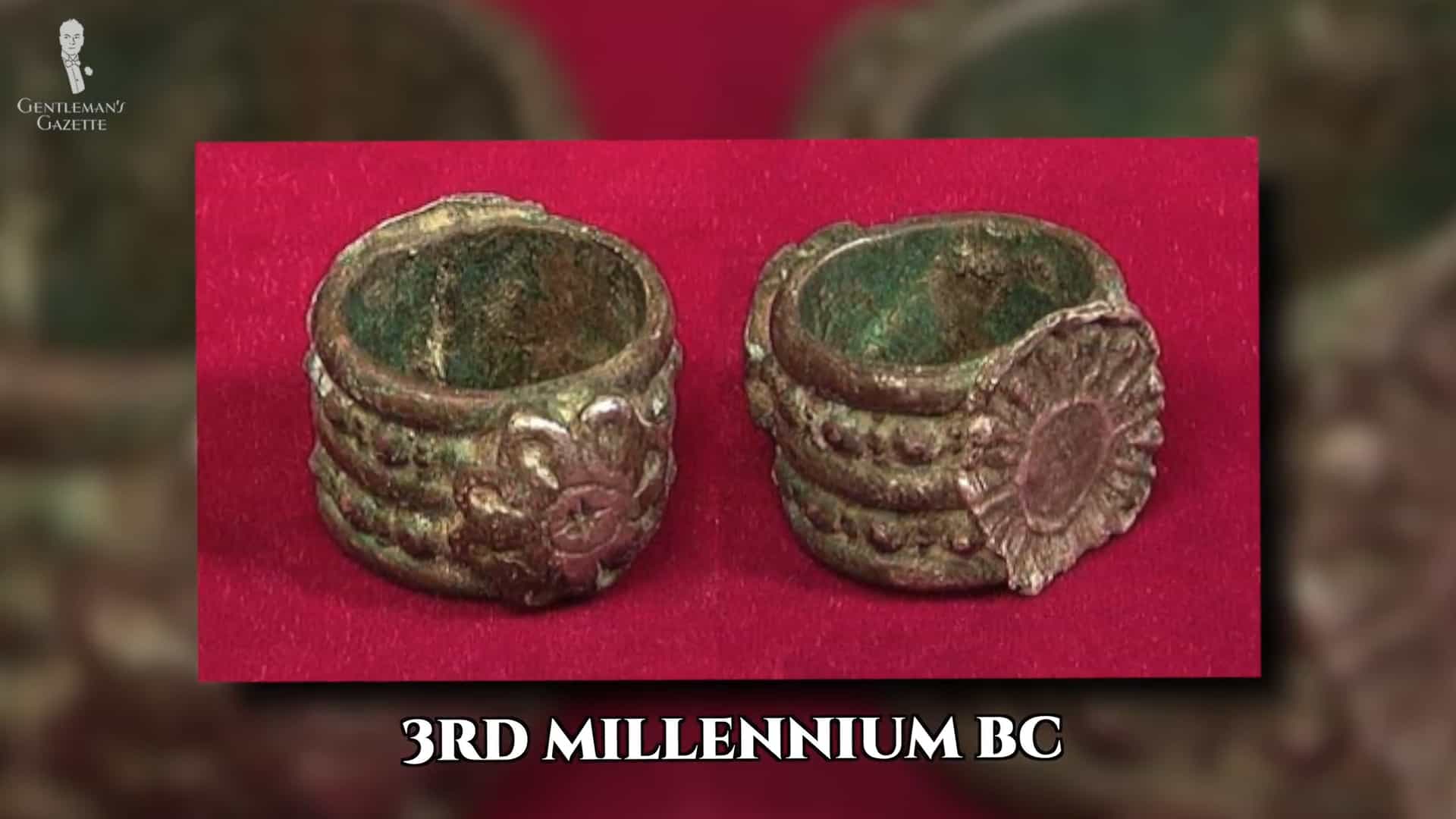
What all of these pieces of jewelry have in common is that they were worn by both men and women. Throughout history, men have worn jewelry for personal expression, sometimes, for practicality, and also as status symbols.
But, what types of jewelry were worn and how they were worn have changed throughout the centuries. For instance, the Ancient Egyptians combined form and function with signet rings that both looked beautiful, but also could be used to stamp seals on official documentation. Meanwhile, the Ancient Chinese decorated their heads with gold, pearl, and jade hair accessories.
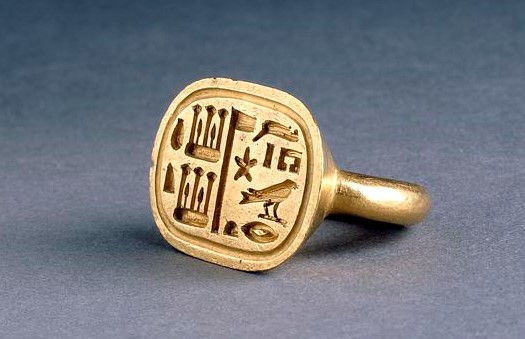
Militaristic societies, like the Scandinavian warriors of the early Middle Ages, wore massive rings and armbands of gold that displayed their wealth but were also portable, while the pre-Columbian Aztecs pierced their bodies with nose plug jewelry that was made from semi-precious stones or precious metals.
The German epic Das Nibelungenlied is one example where rings worn by both men and women feature prominently in a work of medieval literature. It would inspire a later fantasy series about a ring that held immense power. We’re talking about Richard Wagner’s “Ring Cycle,” although t J. R. R. Tolkien wrote books that also featured powerful rings, and they made those into movies, too.
In early modern Europe, earrings were commonly seen on both men and women, like the ones on William Shakespeare in the famous Chandos portrait.
Jewelry was often tied into the functional components of a gentleman’s clothing. And as the modern suit developed, so too did many of the varieties of men’s jewelry with which we’re now familiar begin to evolve.

Of course, there were also many other types of men’s jewelry that most people today probably haven’t heard of, unless, of course, they’ve read our post on obscure men’s jewelry, where, for example, we answer what on earth a tussie-mussie is.
Decorative jewelry for men remained popular well into the 20th century. As a particularly opulent example, we can see images of Sir Yadavindra Singh, Maharaja of Patiala, literally sparkling in a collection of gold and gemstone necklaces, choker, headdress, chains, and a crown.
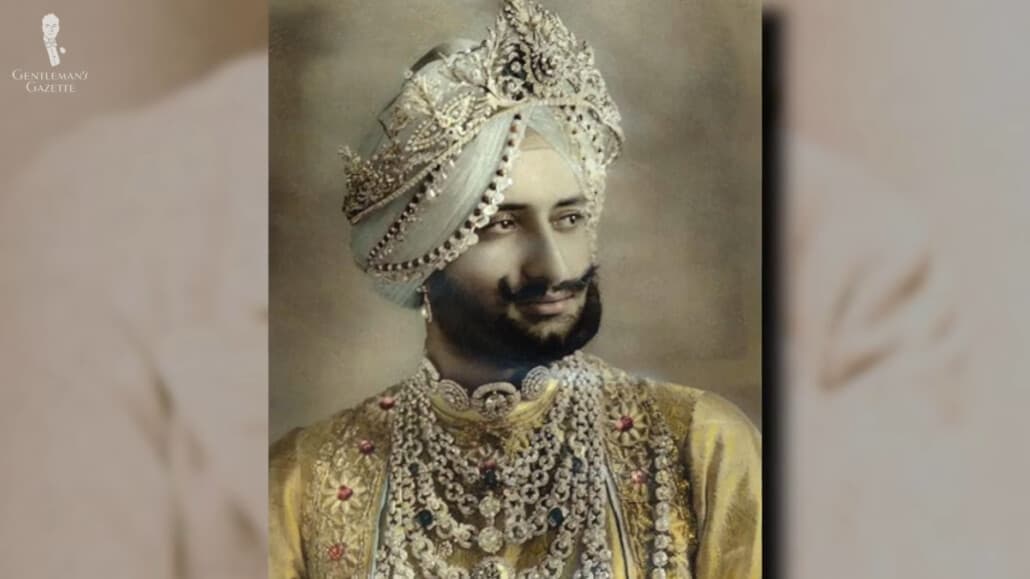
For some more recent examples incorporating some of the same jewelry throughout the 20th century, we can here see Antoine “Fats” Domino wearing a ring, Jean-Paul Belmondo wearing a bracelet, and Alain Delon with a necklace and pendant.
In fact, immediately after each World War, veterans who had been wearing uniforms for years, and civilians, who had been under rationing, celebrated the end of the war by ushering in a renaissance of accessories. They would regularly sport things like collar bars, cufflinks, tie pins, and rings.
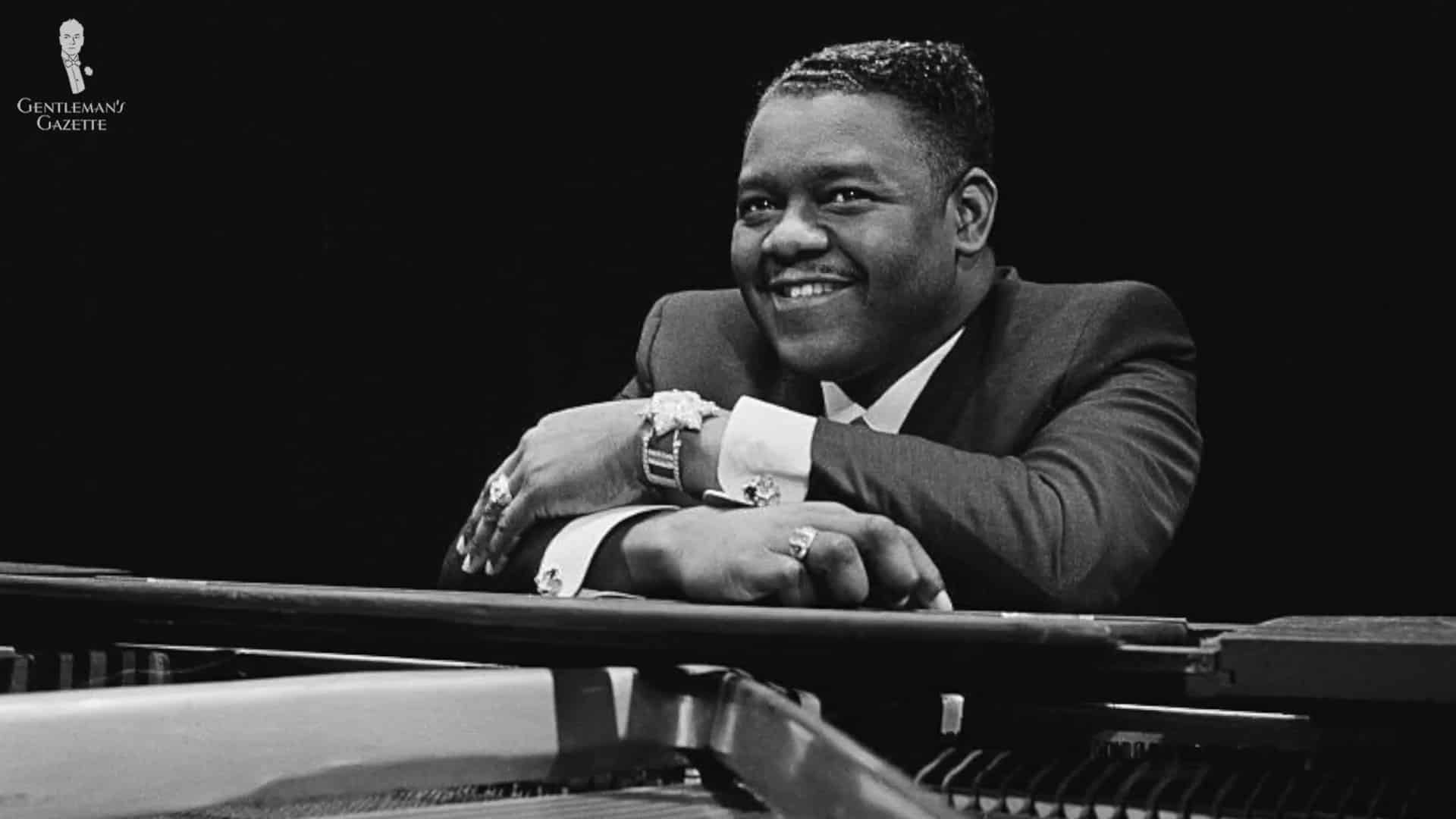
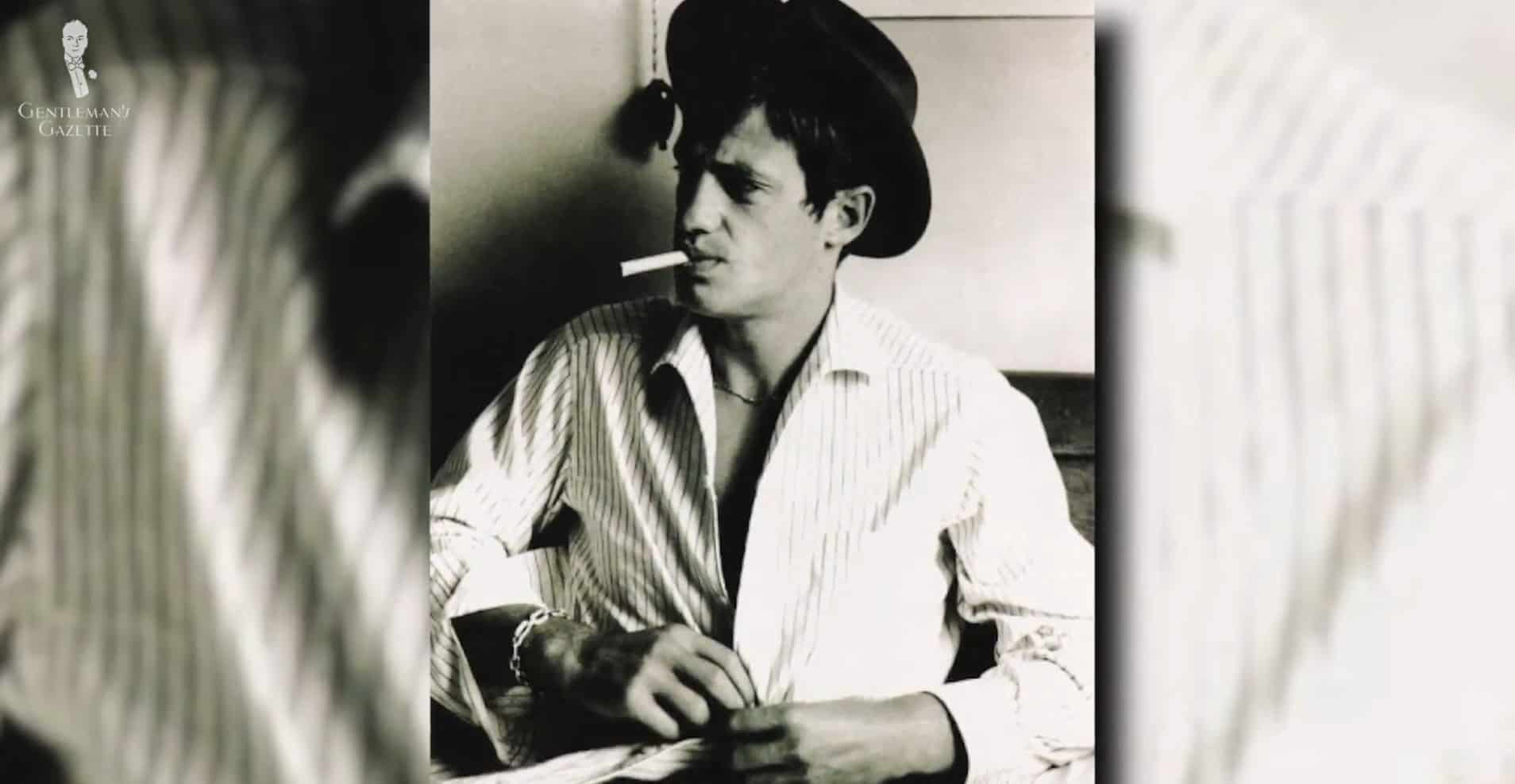
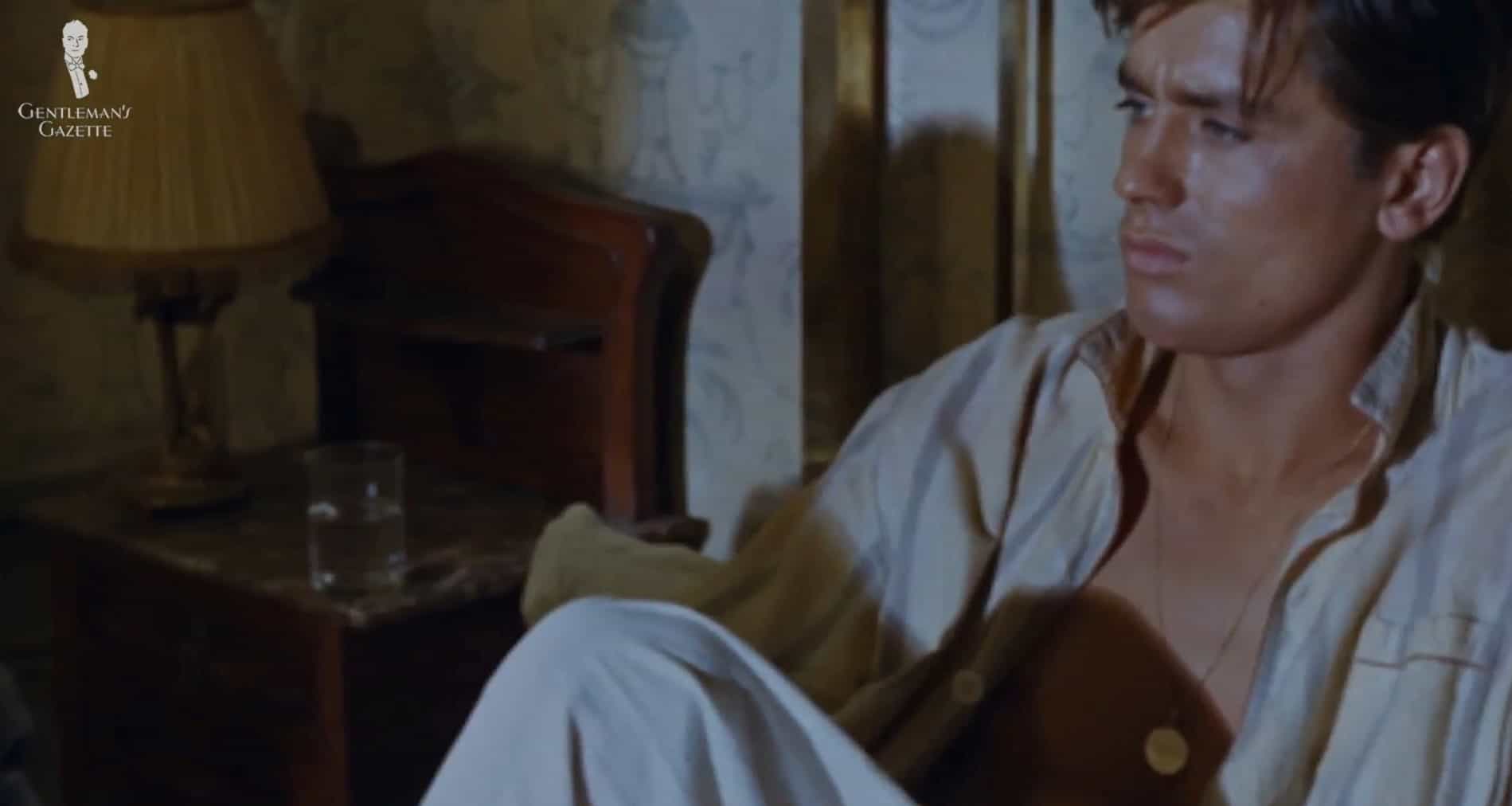
Men’s jewelry in the 20th century tended to be relatively subdued until the late 1960s. Around this time, men started expressing more of an interest in bigger, chunkier jewelry like thick gold chains and bolder rings. To a certain extent, this trend still persists to the present day as men’s jewelry is still worn as a status symbol by various communities and subcultures.
Conversely, however, some men still steadfastly refuse to wear jewelry, erroneously believing it to be effeminate. This is despite its long and storied history of being worn interchangeably between genders.
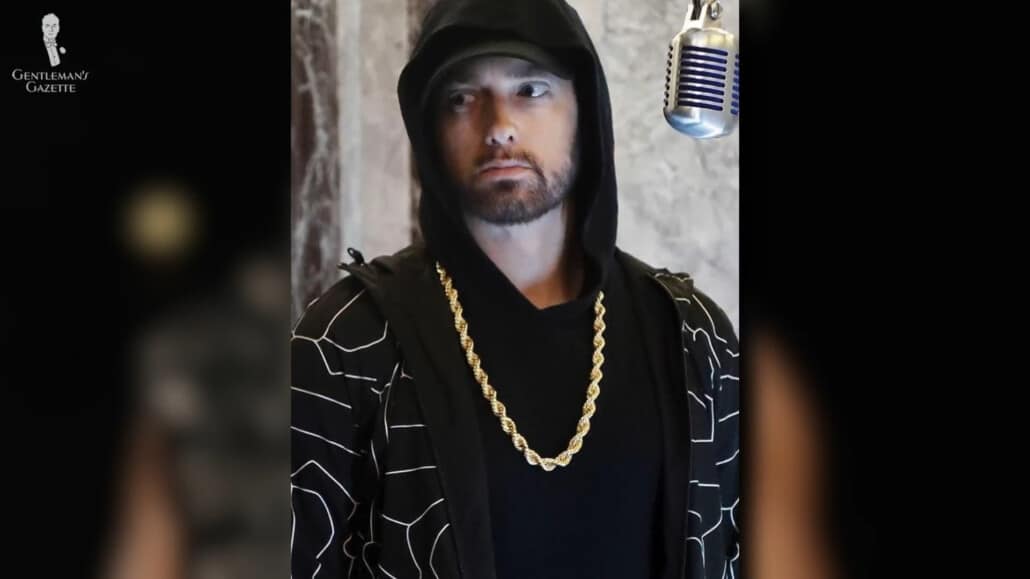
So, just like we mentioned in our post on men’s cosmetics, you should never let societal gender rules dictate what it is that you can and can’t wear if you’d like to wear something in a way that has meaning to you.
Classic Men’s Jewelry Worn Today
One note here to start, we’re not going to be covering timepieces today, as we’re saving them for other guides in the future, so stay tuned.
Functional Jewelry
The first category of jewelry we’ll be discussing today is functional items, which can be ornamental, but also serve a purpose of some kind.
1. Cufflinks
We’ll start with the implements designed to keep your shirt cuffs together: cufflinks. Nowadays, barrel cuffs with attached buttons are the simplest and most practical, as well as the most commonly seen, way of keeping your shirt cuffs from flapping away merrily in the breeze.
However, as you should be able to tell from the plethora of guides we’ve already produced, cufflinks are one of our favorite classic men’s accessories.
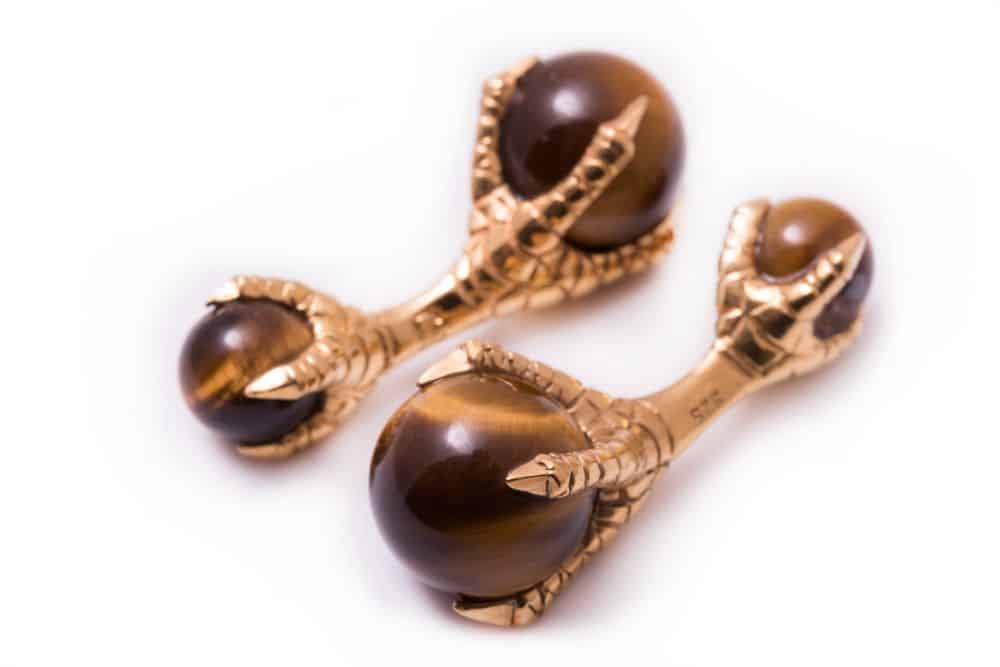
While we’ve already covered them in great depth in our definitive guide, we’ll link our content together with a few off-the-cuff remarks today.
Cufflinks are one of the most common forms of men’s jewelry in the classic style, and all you need is a French cuffed shirt to enjoy them. They’re available in a dazzling array of materials, designs, colors, and styles.
Cufflinks are typically classified by their closure method and, while there are many types, there are three principal categories.
Chain
The first type is the chain, which is the oldest one. It is traditionally elegant, but it can run the risk of looking a bit slovenly if the chain isn’t of the right length relative to your shirt cuffs.
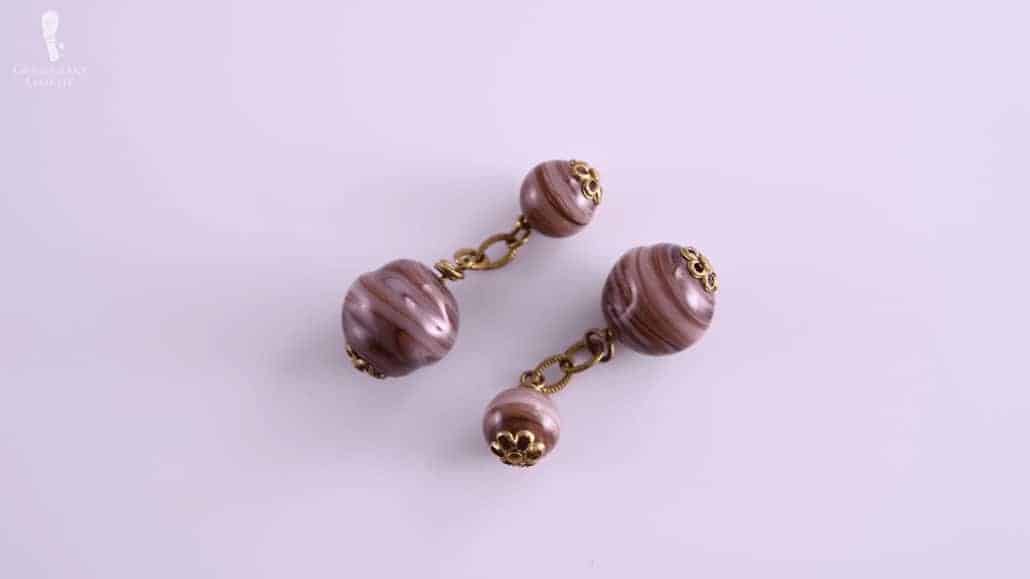
T-Bar
The T-bar, the most common style today and includes such styles as the bullet back and whaleback. It does its basic job well, but because the backside of these cufflinks isn’t decorated, but rather purely functional, they can be a bit pedestrian.
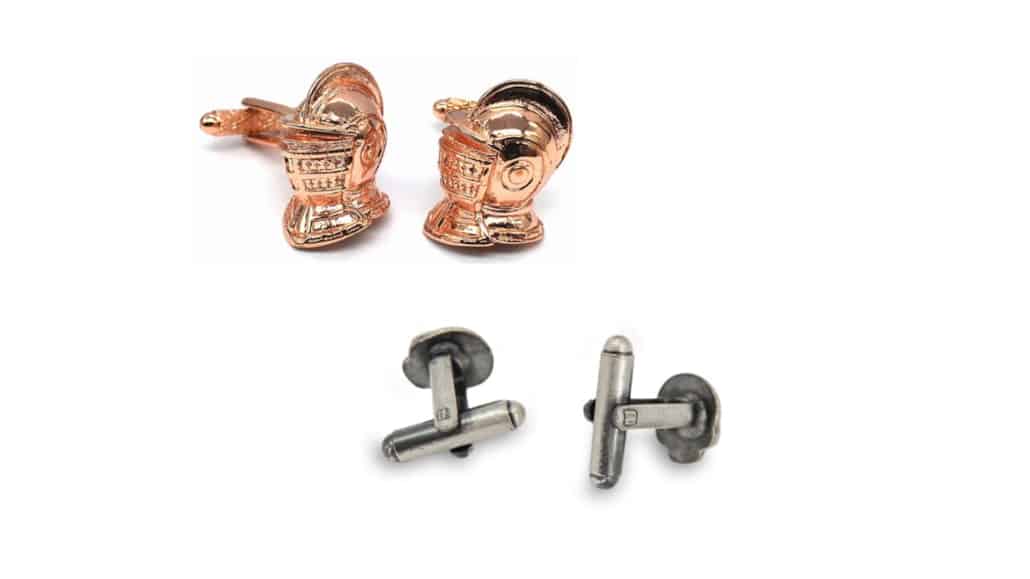
Fixed Double-Sided
Finally, here, we’ll mention fixed double-sided cufflinks, which we believe to be the best type because they provide a secure closure and look great while doing so. All of our Fort Belvedere cufflinks, whether they be our monkey’s fist knot style or our eagle claw style featuring precious stones, are double-sided for just this reason.
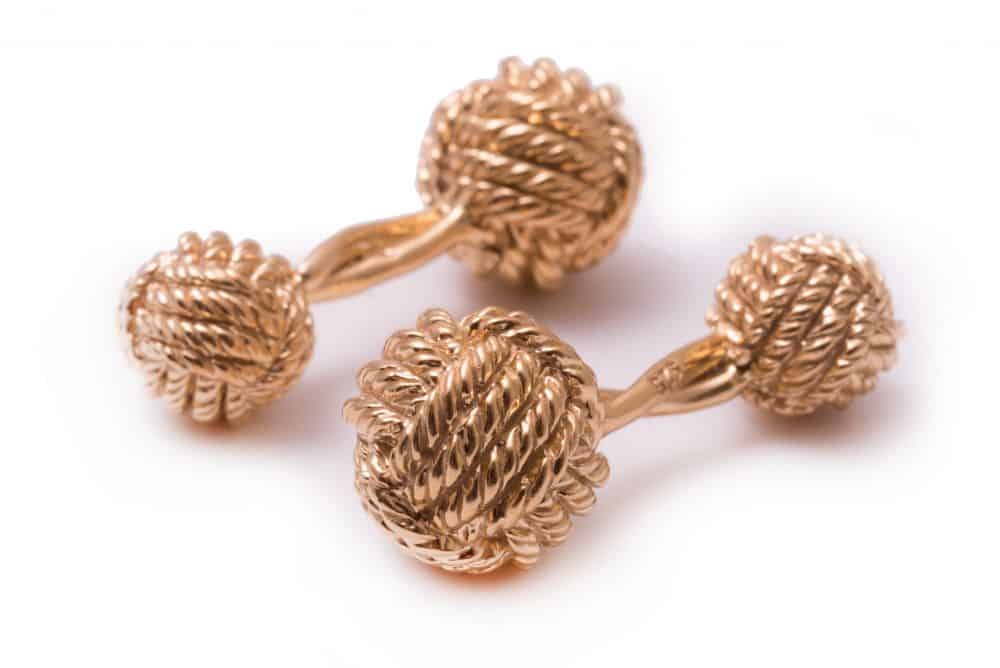
2. Tie Retainers
Tie bars, clips, pins, and chains all have the same basic functionality, which is keeping your tie in place so that it doesn’t blow around in the breeze or get caught in your soup. But, the method by which each of the tie retainer types does this varies.
Tie tacks, for example, usually have a backing piece that is attached to the shirt via a T-bar on a chain. Then, a decorative pin is inserted through the tie and into the backing piece. This is a very secure method, but because it requires sticking a pin through your tie. It’s best reserved for woven silks or coarser materials.
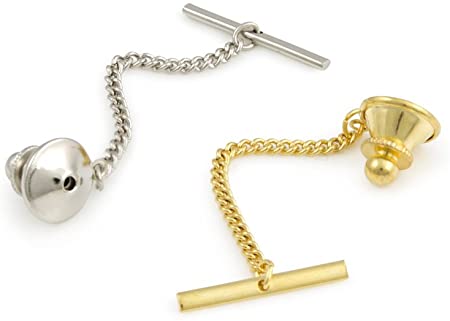
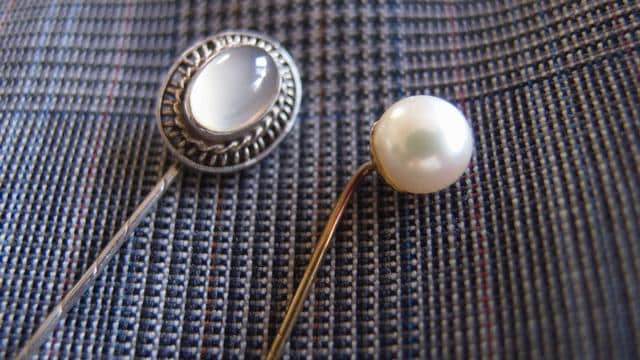
The older brother of sorts to the tie tack is the stick pin, which is simply a decorative pin that’s inserted through both the shirt and the tie. These can be worn in a variety of ways as Raphael discusses in our tie bar and tack primer.
Tie bars avoid damaging your tie by sliding over both the tie and the shirt and using tension to hold things in place. And, for a tighter hold, tie clips employ a spring to hold the tie and shirt together with greater tension.
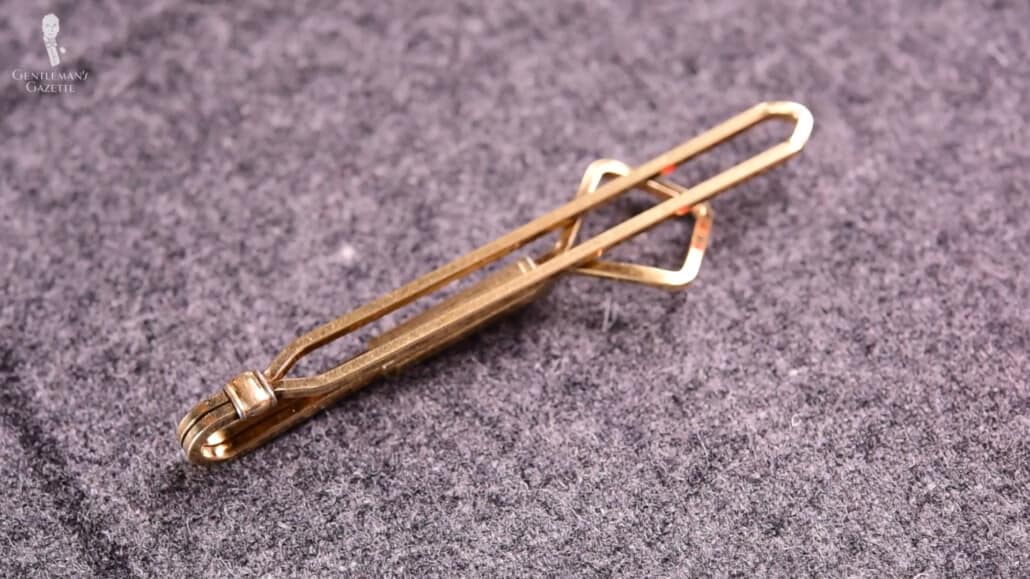
Both tie bars and tie clips come in varieties that feature a decorative chain, and there are also stand-alone tie chain styles that usually slip over a shirt button to stay in place. Any of these chain styles can also sometimes feature decorative pendants as well.
Tie retainers, overall, aren’t quite as functional as other types of men’s jewelry, and, indeed, the same task can be performed in a much more subtle way by the simple tie strap. But, they are a good way to add a bit more flash to your ensemble with a vintage feel.
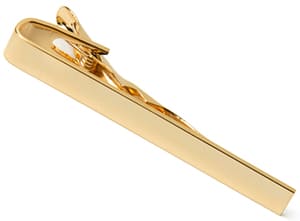
3. Collar Retainers
Next, we’ll move up the body of the shirt, while retaining the same overall functionality, with collar retainers. Originally, intended to give softer shirt collars a neater and more refined appearance. These types of men’s jewelry are a bit rarer today, and those that you can find will generally come in three main types.
Collar Pin
Collar pins have a sharp point that pierces and connects the leaves of the collar in a fashion similar to a large safety pin. These have the benefit of being easy-to-use. And, while they do necessarily have to poke holes in your shirt collar, the more well-made varieties with especially fine points.
The collar pins we offer in the Fort Belvedere shop, for example, should do minimal damage to your shirt collars. And, indeed, the holes should close up after laundering your shirts.
Of course, if you hate the idea of even potentially damaging your shirt collars at all, you could consider collars that come pre-made with pinholes accordingly called pinhole collars.
A pinhole collar also has the added benefit of working equally well with both collar pins and our next jewelry type: collar bars.
Collar Bar
Collar bars have a removable cap on at least one end, if not both, so they can be easily inserted through pre-made holes in the shirt collar and then secured down again.
Collar Clip
Finally here, as an excellent middle ground, you can consider the collar clip. These can be worn on shirts that don’t have pinhole collars but also won’t damage the fabric. You can also find collar retainers that feature chains. But, historically, these weren’t quite as popular, and we personally find them to be a bit gaudy. Each to his own though.
While not quite to the same extent as tie retainers, collar retainers also have experienced a bit of a resurgence in popularity over the last few decades. If you know where to look, you can find many great vintage pieces in second-hand stores or online.
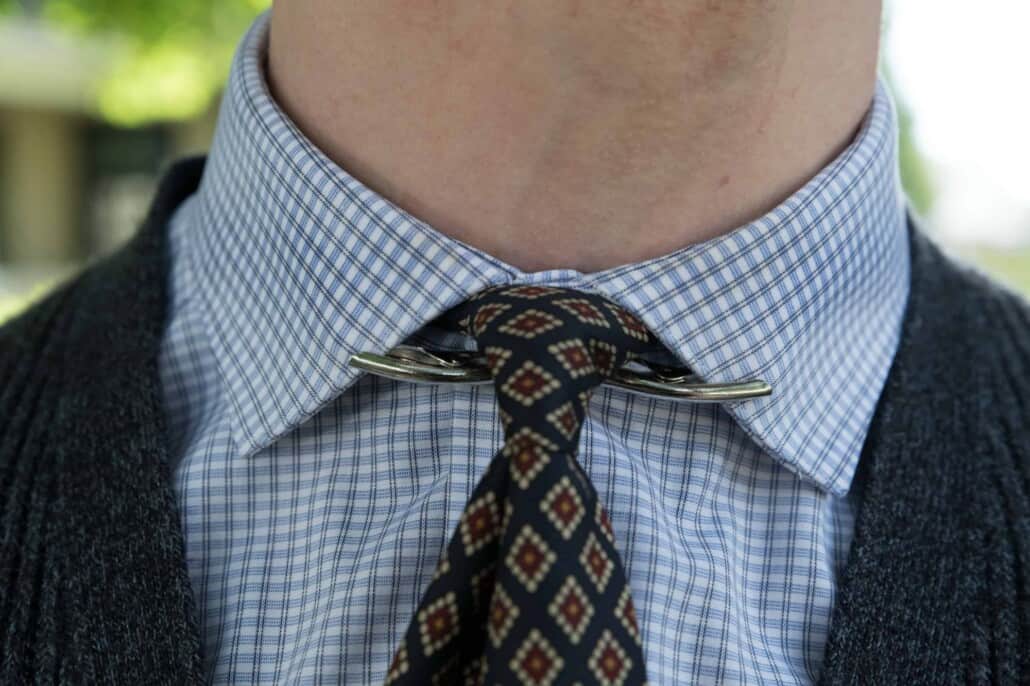
For even greater convenience, though, you can visit the Fort Belvedere shop as we offer a wide selection of collar clips, bars, and pins in various metal colors.
4. Shirt Studs
Shirt studs were once worn as a part of regular day wear but found particular utility with heavily-starched, stiff dress shirt fronts because regular buttons were unwieldy in that circumstance.
Nowadays, though, shirt studs are primarily within the domain of Black Tie and White Tie ensembles. Typically, a man should try to match his shirt studs with his cufflinks for a harmonious look. And, if you’re lucky, you can find a vintage set that will contain matching studs, cufflinks, and studs for one’s waistcoat as well.
Generally, while Black Tie studs can be slightly bolder and White Tie studs are a bit more reserved, you’re going to find metals like platinum, silver, and gold, and precious or semi-precious stones. Again, you can find some truly spectacular examples of vintage studs.
However, keep in mind that these are often sized for vintage shirts and may not harmonize quite well with modern ones. But, for a selection of studs that will work equally well with modern and vintage styling, you can consult the Fort Belvedere shop, and our definitive guide to shirt studs should hopefully help you as well.
5. Belts and Belt Buckles
As belts and their buckles have become more standardized, most men probably don’t consider their hardware to be jewelry. But, in the past, a separate and individual belt buckle was an essential piece for any man’s wardrobe.
Today, most non-standard belt buckles are more casual in overall style and should be worn accordingly. Heavily decorated, detailed, or oversized belt buckles should not be worn with formal dress or with suits.
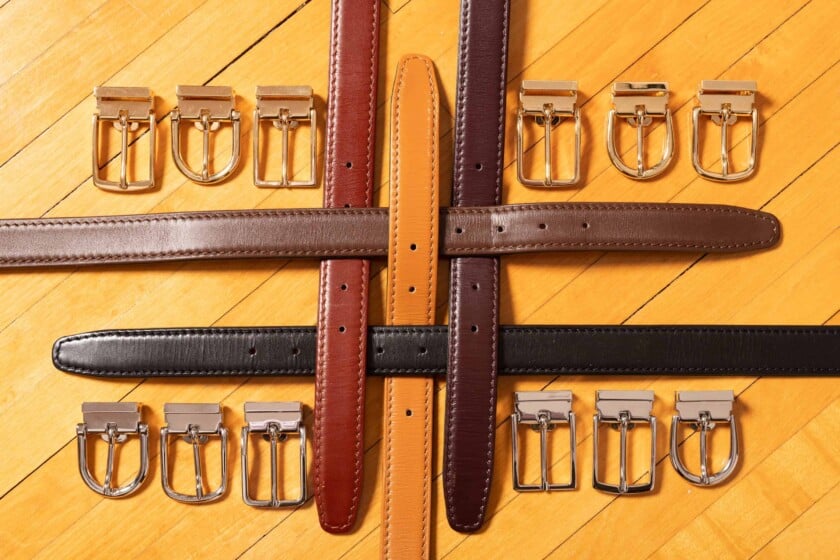
Of course, there are exceptions, such as is the case for uniforms or specific culturally-significant ensembles, or, if you really want to explore the viability of something like a rustic, semi-formal dress code.
To add a bit more personality to your belt buckle though, you could consider employing a modular system that would allow you to swap out various configurations of belts and buckles.
6. Chains & Fobs
Particularly in the 19th and early-20th centuries, functional chains and fobs were also employed in menswear. These implements were typically anchored to the belt, waistband, trouser pocket, or waistcoat pocket and fulfilled a variety of needs.
Especially when it came to the zoot suits of the 1940s, these chains often featured things like penknives, pocket watches, lighters, toothpicks, keys, or other decorative elements. The chains themselves, though, were exaggeratedly long to add flair and panache.
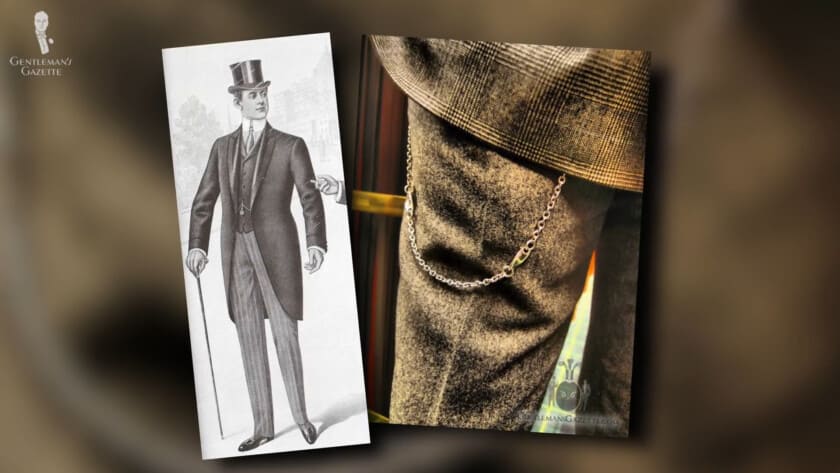
As the 20th century progressed, the typical length of a chain would get shorter overall. Chains are still sometimes attached to men’s wallets for functionality, as well as visual interest, but as we’ve seen with other jewelry we’ve discussed today, chains are often incorporated into menswear today as a purely decorative element rather than a functional one.
Ornamental Jewelry
So, let’s get into our second broad category today, which is jewelry that is purely or, at least, primarily ornamental in nature.
1. Rings
Rings are one of the most common jewelry items for women as well as men. The types of rings include wedding rings, signet rings, which are reminiscent of the rings used to seal wax on documents and often contained a crest or other personal motif, and honorific rings.
The most common type of honorific ring is probably the class ring, honoring an educational institution, though other types also exist, such as honorific rings for organizations like the military, religious vocations, fraternal organizations, and athletic endeavors.
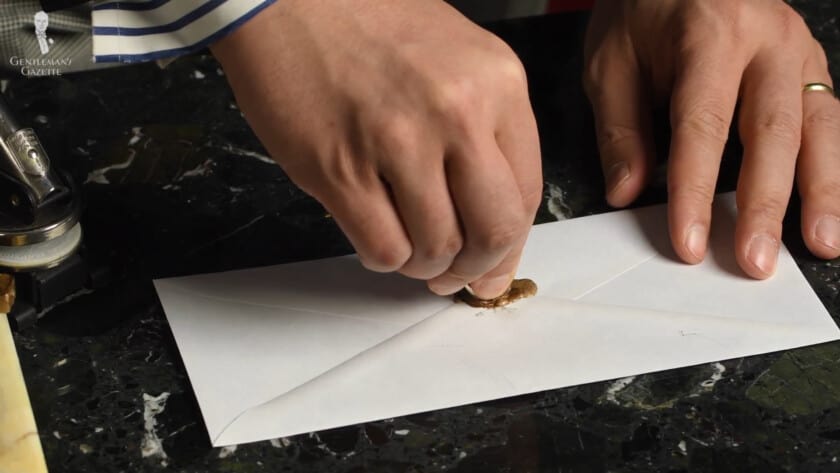
Rings can also be categorized by the fingers on which they’re worn and, as an example, pinky rings were quite popular throughout the 20th century. You can learn more about them in our pinky ring guide, or you may want to check out Raphael’s personal collection of them.
As you might have guessed, this also means that there are often specific meanings and associations behind the rings that a gentleman wears on each of his fingers, which we also made a post about.
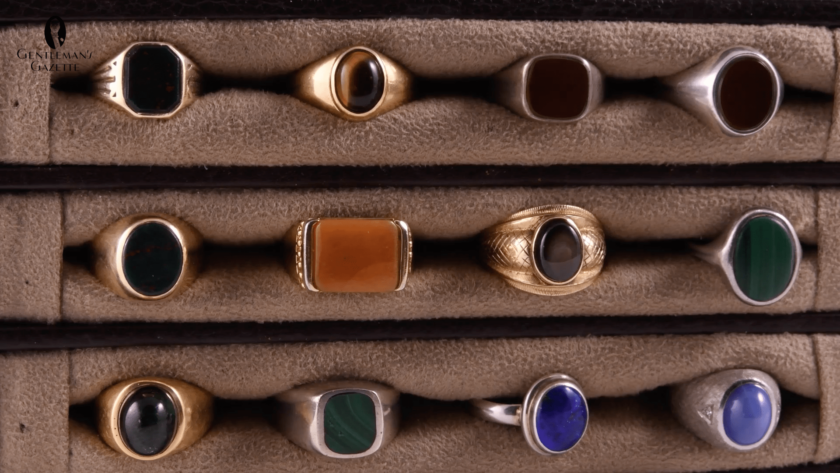
As a common rule of thumb, you should wear no more than one ring on each hand for a subdued look. For most men, this will typically mean a wedding ring on one hand and one other ring on the opposite hand.
2. Lapel Pins
While we here at the Gentleman’s Gazette typically prefer to wear boutonnieres in our lapel buttonholes, a lapel pin can also be a tasteful way to add some personality and visual interest to your outfit while expressing your own interests in a slightly more playful and whimsical way.
The decorative face can display almost anything from a love for comic books to a classical symbol. And given our overview of some of the other jewelry types, varieties incorporating chains have also become popular in recent decades.
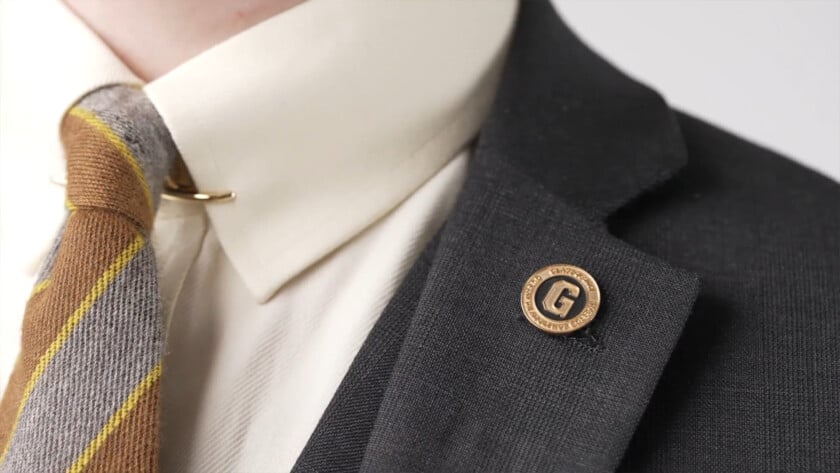
While some lapel pins, especially, modern ones consist of those with a longer pin style that is meant to be inserted through a length of the lapel and can often come out again through the front side, the more subtle and elegant style consists of a simple backing, which will remain behind the lapel.
Again, anything too large, exuberant, novel, or kitsch is probably going to look out of place, so think critically when choosing what lapel pin to wear and when to wear it.
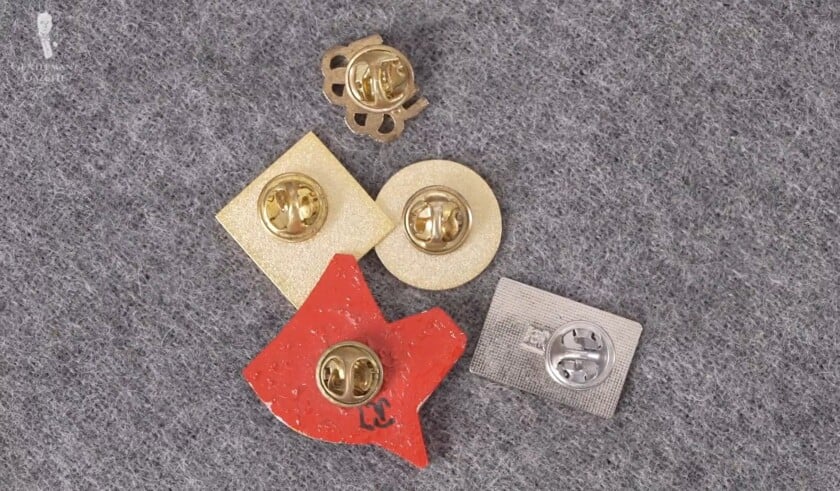
Also, lapel pins are a popular way to indicate membership or advertise for organizations, companies, and political parties. Many groups encourage their members to wear lapel pins to identify themselves or to celebrate unique achievements. Of course, politicians can regularly be seen wearing lapel pins featuring their national flags.
So, you should have ample opportunity to wear a lapel pin and many different styles from which to choose. So, as long as you’ve got that buttonhole in your lapel, you might as well use it.
3. Necklaces
While men in the 19th and 20th centuries did often wear necklaces, these were typically covered by his shirt and so, wouldn’t directly be seen in most circumstances, unless he was partially or fully undressed.
Men would also often wear pendants of personal significance on their necklaces, such as religious iconography or other symbols.
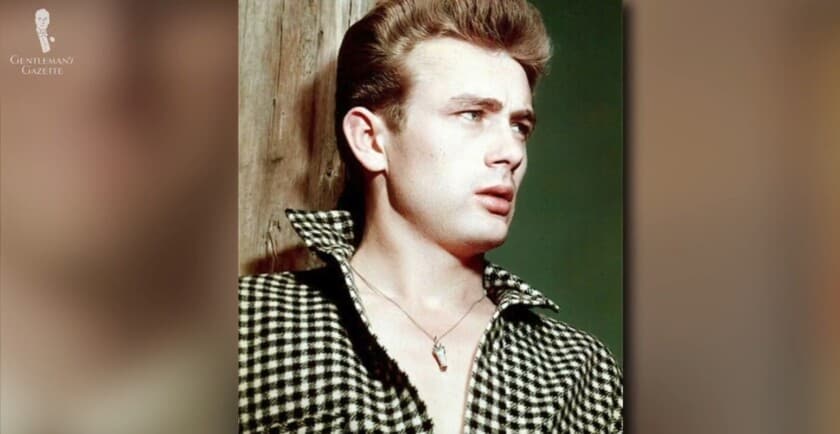
Around the 1960s, though, it became increasingly common for men to wear larger and more flamboyant necklaces that were designed to be seen as a deliberate part of an outfit. And, as we mentioned before, this trend has continued in some circles even today.
When it comes to more firmly classic ensembles, necklaces are still usually kept discreet, though they can still be glimpsed if a man has his shirt collar open, and there are occasional ensembles that will incorporate a more directly visible necklace or chain.
4. Bracelets
While many men still wear rings and necklaces today, bracelets are somewhat less common. Particularly around the middle of the 20th century, though, they were actually quite a common accessory.
Traditionally, these were simple chain bracelets in precious or semi-precious metals, and these are still going to be the styles that are the most versatile and classically elegant. Bracelets worn by most men today are typically going to be made from other materials, though, such as fabric, leather, or beads.
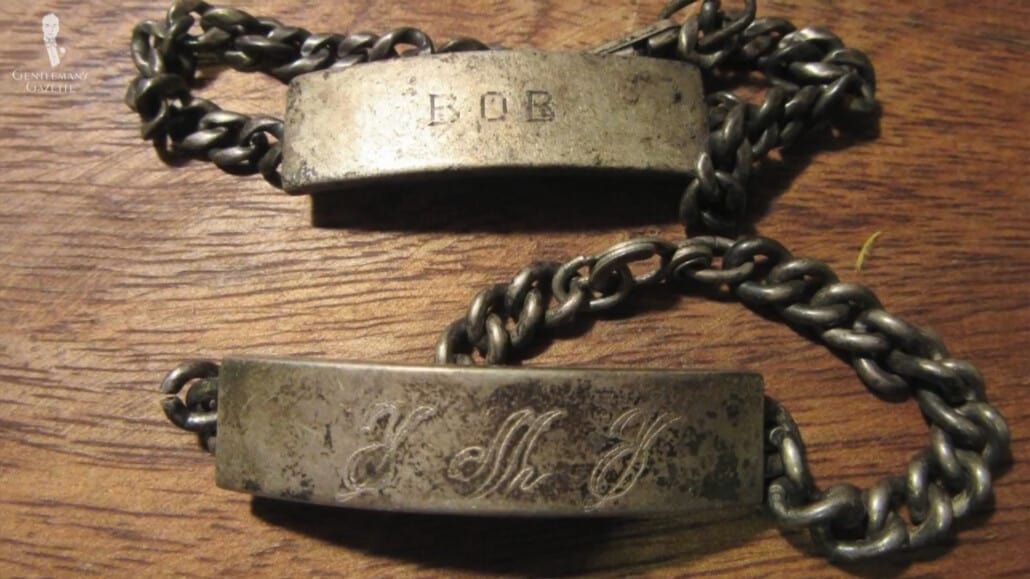
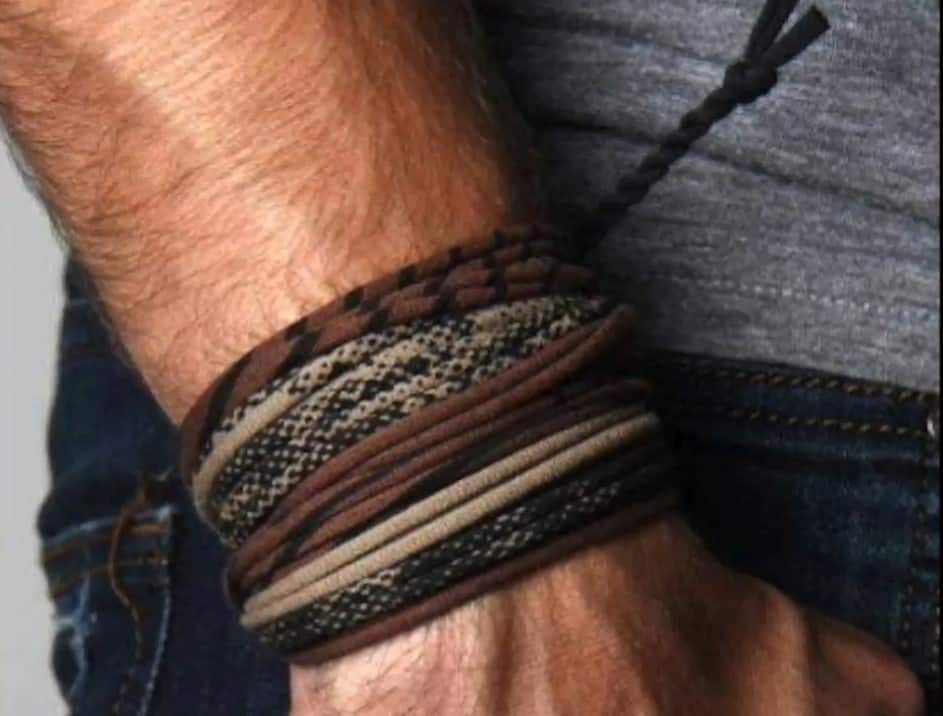
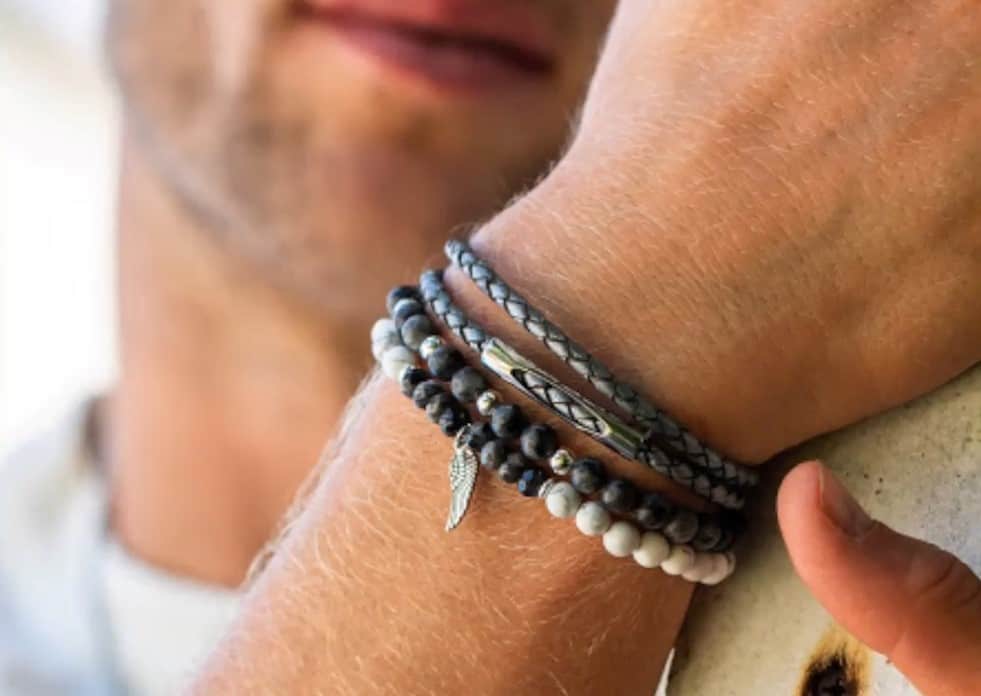
Whatever the case, bracelets have traditionally been seen as a more casual piece of jewelry and, typically, only metal varieties would be worn with formal ensembles, if they were worn at all. And the closely-related anklet would also follow most of these same guidelines.
Of course, tasteful and subdued accessories can always be carefully incorporated into a classically-styled ensemble, and bracelets are no exception.
And if there’s any bracelet that could be included within the functional category, it would of course be the medical bracelet. For those who need to wear it, this is a medically necessary accessory and can, of course, be worn with any ensemble, regardless of formality.
5. Earrings
If there’s one type of classic men’s jewelry that was even more rarely worn than bracelets, it would probably be earrings. They were rarely worn during the Golden Age of menswear, despite a long and storied history of being worn by men in various cultures throughout the centuries prior.
Particularly during the 20th century, rumors and urban legends associating earrings with homosexuality emerged, and thus, a stigma against earrings unfortunately developed. These prejudicial associations are on the wane though, and more and more men today are choosing to incorporate earrings into their look.
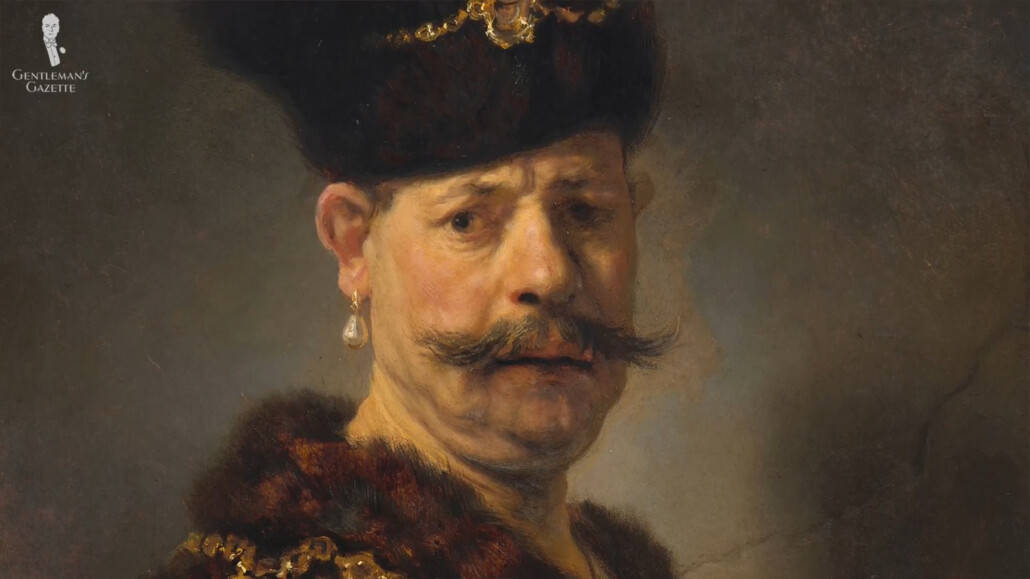
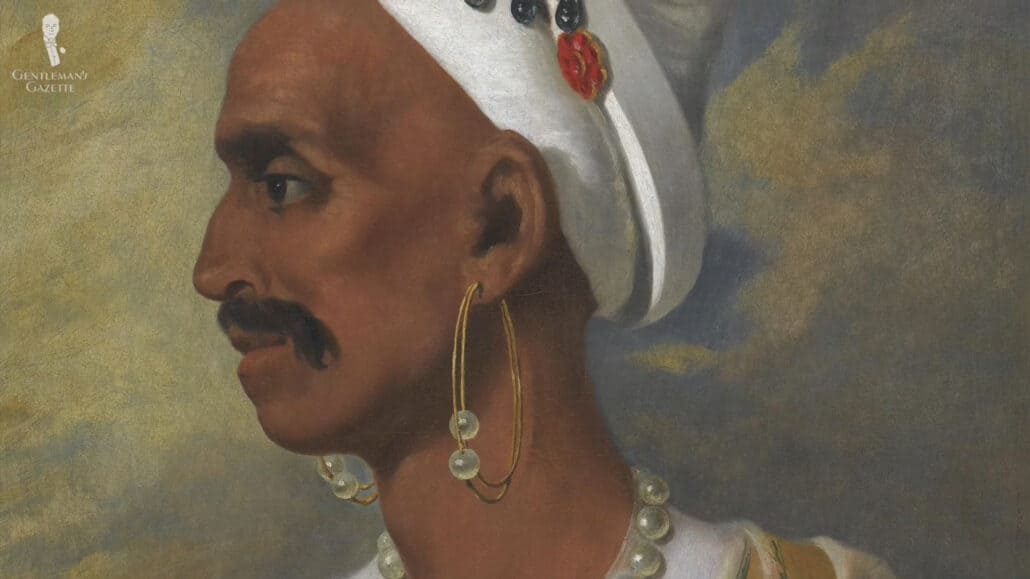
And despite the fact that no one here on the Gentleman’s Gazette team wears them, aside from Teresa that is, we believe that tasteful earrings certainly can be incorporated into more classically-styled ensembles.
Conclusion
As we wrap up today, you’ll probably notice that we spoke very little about how to actually style and incorporate jewelry items into your outfits, and the simple reason for this is that we covered it in great depth in our Jewelry Dos and Don’ts post.
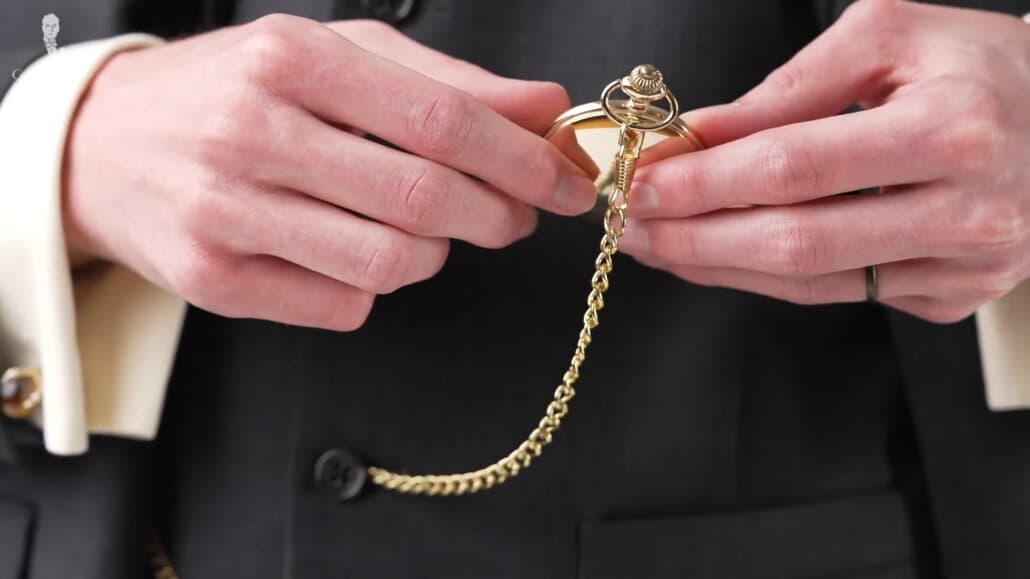
So, in general, we would suggest that you keep the following basic rules in mind:
- Emphasize quality over quantity.
- Select jewelry that’s appropriate to the occasion and location, and that is respectful and tasteful.
- Wear jewelry that you like and that looks good on you.
- Don’t dress just to impress others.
- Lastly, don’t let gendered or cultural assumptions about jewelry dictate what you do or don’t wear.
Outfit Rundown
I’m wearing an outfit that features a few different types of men’s jewelry, in accordance with the types we discussed today. Two of the types of men’s jewelry are from Fort Belvedere and are my cufflinks, which are our gold-plated sterling silver eagle claw models featuring tiger’s eye as the stone, and my collar clip in yellow-gold. The other piece I’m wearing is a simple gold pocket watch that also has an accompanying gold chain.
Because I didn’t want any of these jewelry pieces to overwhelm my outfit, though, I’ve chosen to wear other pieces that are mostly more subdued. Chief among these, of course, would be my charcoal-gray three-piece suit, which features a slight bit of pattern and texture to its weave. I’m also wearing a pastel yellow shirt, which, of course, features a point collar and French cuffs and a vintage cashmere tie in yellow, orange, and gray. My shoes are plain black, cap-toed Oxfords from Carmina.
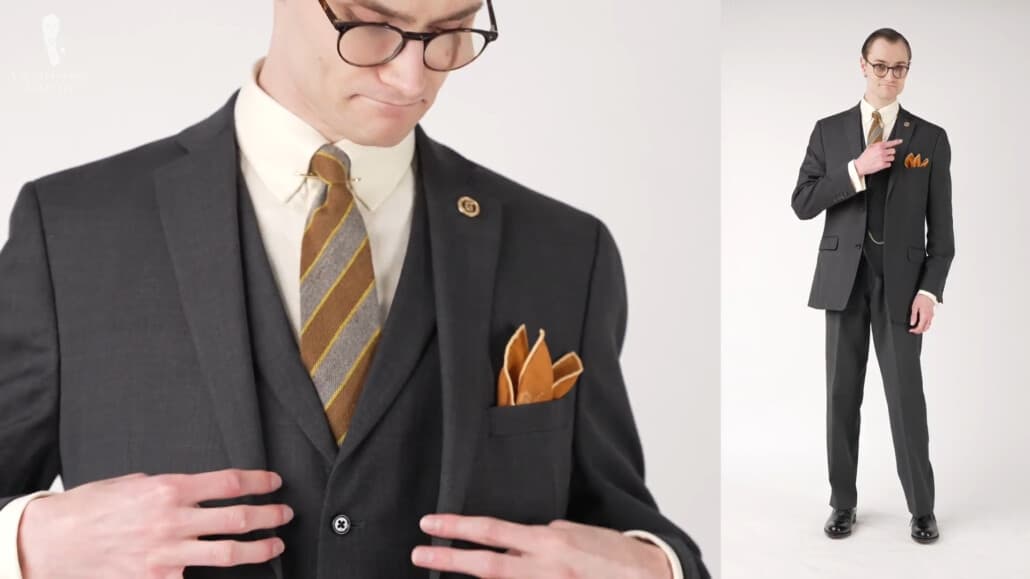
And my other Fort Belvedere accessories include our shadow striped socks in charcoal gray and orange and my silk-wool pocket square, which is in a color we’re calling “antique gold ochre.” It features printed geometric medallions in beige, red, and blue, but the pointed fold. I’ve got the pocket square configured, which means that you are only seeing the base color, as well as the cream contrast edge. One additional small piece of jewelry also discussed was my lapel pin. This one is to commemorate my graduation from Gustavus Adolphus College in 2017, and it’s also in a gold color to harmonize with my other jewelry pieces. And, of course, my dark metallic wedding ring could also be included in the jewelry conversation, but considering I wear it every day and with all of my outfits, it wasn’t a deliberate choice.
To find all of the Fort Belvedere accessories I’m wearing, as well as a wide variety of other accessories and jewelry, you can consult the Fort Belvedere shop here.
